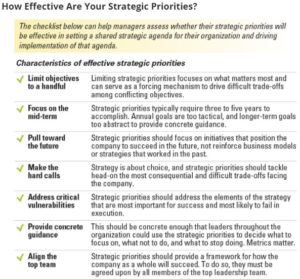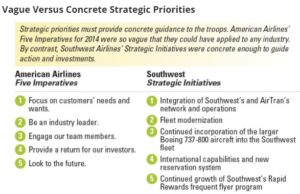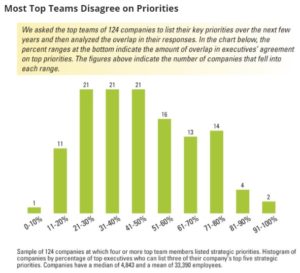How can leaders translate the complexity of strategy into guidelines that are simple and flexible enough to execute? Rather than trying to boil the strategy down to a pithy statement, it’s better to develop a small set of priorities that everyone gets behind to produce results.
Strategy, at its heart, is about choice. Few companies succeed by making a single big bet. Most winning strategies are based on a bundle of choices about, among other things, the customers to serve, the scope of the business, product offerings, and capabilities that interact with one another to help a company make money. Consider Trader Joe’s Co., the U.S. grocery retailer based in Monrovia, California. It focuses on educated, health-conscious customers, which influences where it locates its stores, which products it stocks, and the type of employees it hires. The company’s choices reinforce one another to increase customers’ willingness to pay, reduce costs, and thereby drive profitability. The dense interdependencies among the choices prevent rivals from imitating Trader Joe’s winning strategy. Piecemeal imitation of a few elements – for example, the store format or the focus on private labels – wouldn’t work. Instead, a rival would need to replicate the full set of interconnected choices.
Strategy is inherently complex. We see this in the thick reports and complex frameworks that companies use to describe their strategic choices and how they connect with one another. Describing a strategy favors complexity, but executing it requires simplicity. To influence day-to-day activities, strategies need to be simple enough for leaders at every level of the organization to understand, communicate, and remember – a strategy that gathers dust on a shelf is nothing more than an expensive bookend. A strategy for execution must provide concrete guidance while leaving managers with enough flexibility to seize novel opportunities, mitigate unexpected risks, and adapt to local conditions. The act of codifying past choices into an explicit strategy, moreover, reinforces historical commitments and locks a company into inertia. Complex strategies, particularly those that include detailed plans, tend to be long on guidance but short on flexibility.
Strategy Made Simple
How can leaders translate the complexity of strategy into something simple and flexible enough to execute? Your first instinct might be to boil a complex set of choices down to a handful that matter the most. Indeed, a series of strategy experts have argued that managers should do just that by distilling their strategy to a concise statement (less than 35 words) summarizing a few core choices. The strategy distillation approach hinges on a few fundamental strategic categories – such as the choice of target customer or core competencies – that can summarize the heart of any company’s strategy. The authors illustrate this approach with strategies they have inferred from observing what has worked in the past at successful companies such as Southwest Airlines Co. or Ikea.
We have learned, however, that this approach works best with companies that have relatively straightforward strategies to begin with. Part of our research on strategy execution included a four-year action research project in which we worked with top management teams of eight to 12 companies per year in formulating strategies for execution. The teams used a framework that boiled down their company’s strategy to three elements: target customers (who), the value proposition (what), and how the company would deliver, sell, and distribute products or services (how). The approach worked well for a subset of the companies, including a low-cost regional airline, a single-format retailer, a restaurant chain, and a producer of steel girders. Although operating in different industries, the companies shared three characteristics: They focused on a single business, offered a standard value proposition to a clearly identified customer segment, and their strategy was stable over time.
Executives in companies that didn’t fit this mold, by contrast, struggled to boil their strategy down to a few key choices. An online job site in Eastern Europe, for example, could not identify a single customer because it served job seekers, employers, advertisers, and partners that listed jobs in multiple countries. Leaders also found it difficult to combine corporate and business unit strategies into a single formula. One company ran an online high school and a separate division that developed digital content, which it sold to other educational institutions (including other high schools). The two divisions were deeply interwoven, but the leadership team never managed to articulate a single strategy that worked for both parts of the business.
Strategies in transition posed another challenge. Combining choices that drove historical success with those required to win in the future resulted in convoluted statements that left employees baffled as to where they should focus. Simple strategies, we found, don’t work for companies that compete in multiple businesses, serve multiple customers, or are in the midst of a strategic transition.
Distilling a strategy into a few core choices sounds great in theory, but often derails in practice. You might think the issue was the specific framework we chose, but the roots of the problem go much deeper. To differentiate a company from rivals, the strategy should be specific to the company’s history and context, which implies the list of potentially strategic choices is long. Any short list of essential factors is likely to exclude choices that are critical to some companies. To be clear, this critique is not meant to devalue the work of the strategy scholars who created these frameworks, but rather to underscore the difficulty of reducing the inherent complexity of strategy into simple statements. Many companies simply cannot cram 10 pounds of strategic complexity into a three-pound bag.
If boiling down a complex bundle of choices to a few key elements doesn’t create a strategy for execution, what does?
Strategic Priorities
Instead of trying to summarize their strategy in a pithy statement, managers should translate it into a handful of actions the company must take to execute that strategy over the medium term. Strategic priorities should be forward-looking and action-oriented and should focus attention on the handful of choices that matter most to the organization’s success over the next few years.
Many complex organizations that compete across multiple industries, product lines, and customer segments rely on strategic priorities to advance strategy. More than two-thirds of S&P 500 companies, for example, published explicit mid-term objectives intended to help implement their strategy.
What companies call their corporate objectives doesn’t matter; S&P 500 companies use a variety of labels, ranging from the mundane (strategic priorities, areas of focus, strategic objectives) to the exotic (Microsoft Corp. referred to “interconnected ambitions” and retailer Kohl’s Corp. talked about “greatness agenda pillars”). (See “Common Names for Strategic Priorities Among S&P 500 Companies.”)

Whatever terminology companies use, their objectives share a few common characteristics. They typically extend three to five years — shorter than that is too tactical, longer too visionary. They are limited to a handful — of S&P 500 companies publicizing their objectives, 78% listed between three to five in total. (See “Strategic Priorities Among S&P 500 Companies.”) And they are strategic, in the sense that they describe specific actions that will help the company to execute its strategy, as opposed to financial targets or corporate values.

Many executives tell us that they use strategic priorities but report that the approach isn’t working as well as they had hoped. To set the strategic agenda and drive implementation effectively, we have found that strategic priorities need to balance guidance with flexibility, counterbalance the inertia of business as usual, and unify disparate parts of the business. Crafting strategic priorities that do all of these things — and do them well — is a tall order. The remainder of this article will describe the seven characteristics of effective strategic priorities, explain why they matter, and suggest practical diagnostics managers can use to assess their company’s strategic priorities. The figure below, “How Effective Are Your Strategic Priorities?”, summarizes the seven factors.

- Limit the number of priorities to a handful. Restricting the number of strategic priorities to three to five has several advantages. Most obviously, having a small number will be easier to understand, communicate throughout the organization, and remember. Rather than overwhelming employees with the full set of all choices and interdependencies that make up a company’s strategy, communicating a few strategic priorities can focus attention, effort, and resources on the things that matter most now. The best priorities serve as strategic guardrails. If they know the parameters they must work within, managers and employees can fill in the blanks based on their local knowledge and circumstances.
Having too many priorities is a mistake, but having too few can be a problem as well. One wholesale energy company we studied declared a single strategic priority: to manage risk and preserve value. This was a worthy goal, to be sure, but one that was far too abstract to provide useful guidance to employees. A single priority in isolation is rarely enough to drive a strategy that requires multiple initiatives to work together.
- Focus on mid-term objectives. Strategic priorities act as a bridge between long-term aspirations – embodied in a vision or mission – and annual or quarterly objectives. The types of initiatives that have the biggest impact (for example, building data analytics capabilities, integrating online and physical stores, or entering a new market) typically take a few years. Of course, there are exceptions: A financial turnaround, for example, would require an immediate focus on short-term cash generation and debt reduction. But in general, we’ve found a good rule of thumb is “three to five in three to five” – three to five strategic priorities that can be accomplished in three to five years.
Once you’ve set mid-term priorities, it’s important to stick to them. When a team announces five-year priorities and changes them a year later, employees dismiss those objectives (and their successors) as the “flavor of the month” that they can safely ignore. British fashion retailer Burberry Group plc offers a good example of staying the course. When Angela Ahrendts joined Burberry as CEO in 2006, she announced five strategic priorities (including intensifying non-apparel sales, accelerating retail-led growth, and investing in underpenetrated markets) and selected quantitative metrics for each. Ahrendts stuck with the priorities for seven years, updating employees and investors regularly on progress against each goal, which reinforced the message and the company’s commitment to achieving those objectives. During this period, Burberry’s share price handily outperformed competitors and the broader market.
- Pull toward the future. Strategy should guide how a company will create and capture value going forward, rather than codifying how it made money in the past. In dynamic markets, ongoing success typically requires innovation and change. The things that position a company for the future – for example, entering unfamiliar markets, building innovative business models, or developing new capabilities – differ from business as usual. Both are critical, but they often pull in opposite directions.
Maintaining a healthy balance between the status quo and innovation is hard work. Well-oiled capabilities, established resources, organizational structure, metrics, and rewards favor a company’s legacy business, and employees will naturally default to activities that are familiar, straightforward, and produce predictable results. Keeping the trains running in the core business is necessary for success, but these routine activities will usually take care of themselves without having to be prioritized at the corporate level.
Innovation and change, by contrast, require ongoing attention. New activities are difficult, frustrating, uncertain, and require sustained effort and monitoring to be successful. This is where strategic prioritization can help. Prioritizing forward-looking initiatives can tip the scales in favor of the activities that can ensure future vitality but are most likely to fail without sustained effort.
Striking the right balance between sustaining a legacy business and building for the future requires judgment – there is no cookie-cutter template for getting it right. To gauge whether things are in balance, we suggest leaders look at the mix of priorities in terms of those that support and refine the current business model (for example, cost reduction, operational excellence, serving current customers, extending existing products) versus the objectives that take the company in a new direction (for example, entering new markets, building digital capability, non-incremental innovation). Leaders can also ask how different the business would look in three to five years if they were to achieve all their objectives. No mix of priorities is right for every company, but we have found that leadership teams that don’t examine their strategic priorities tend to overweigh business as usual.
- Make the hard calls. Apple Inc. CEO Steve Jobs often stood at a whiteboard during strategy retreats and personally led discussions among the company’s top 100 leaders to set strategic priorities. The assembled team would generate a long list of possibilities and after much wrangling and discussion, they would whittle them down to a rank-ordered list of 10, at which point Jobs would strike out the bottom seven to ensure the company focused on the most critical priorities.
In organizations of any size, there will be dozens or hundreds of competing and often conflicting priorities. The discipline of honing priorities down to a handful can force a leadership team to surface, discuss, and ultimately make a call on the most consequential trade-offs the company faces in the next few years. When executives make the hard calls and communicate them through the ranks, they provide clear guidance on the contentious issues likely to arise when executing strategy. But making trade-offs among competing priorities is difficult – they are dubbed “tough calls” for a reason. Prioritizing different objectives results in “winners” and “losers” in terms of visibility, resources, and corporate support. Many leadership teams go to great lengths to avoid conflict, and as a result end up producing toothless strategic priorities.
A common way to avoid conflict is to designate everything as “strategic” – one S&P 500 company, for example, listed a dozen strategic objectives. Another way leadership teams resist making difficult calls is by combining multiple objectives into a single strategic priority. A large retailer, for example, listed six key business priorities. So far, so good, but when you dug into the so-called priorities – “focus on the fundamentals of the business,” for example – the apparent discipline proved illusory. “Focus on the fundamentals” included, among other items, inventory management, cost cutting, customers, product categories, in-store experience, execution, speed, agility, lead-time reductions, and developing and retaining staff. If leaders dodge the hard trade-offs, their priorities provide little useful guidance to the troops.
Leadership teams also avoid prioritization by burying their strategic priorities among competing mandates and guidelines. The CEO of a large European bank (not one of the S&P 500), for example, was pleased when his team agreed on four strategic priorities during their strategy retreat. That was the good news. The bad news was that the team tacked them on to what the bank was already attempting to do, using three transformation initiatives, a four-part declaration of principles, four customer service priorities, five core beliefs, eight rules of conduct, nine corporate values, 20 promises to stakeholders, and 120 key performance indicators. Baffled employees ignored the latest directive and carried on with what they were already doing.
- Address critical vulnerabilities. Even when you recognize the importance of making the hard calls, it’s often difficult to know where to focus. Strategy is inherently complex and the sheer number of possible objectives can overwhelm teams. So how can executives move from a complex strategy to a handful of strategic priorities?
A key insight comes from military strategists, who have long acknowledged the complexity of armed conflict. Military planners often visualize the field of operations as a complex system of enemies, allies, infrastructure, popular support, and other features that collectively influence who wins and who loses a war. They then hone in on the so-called “centers of gravity” – the parts of the system that are both critical to the enemy’s success and most vulnerable to attack.
Business leaders can deploy a similar approach by identifying the “critical vulnerabilities,” the elements of their own strategy that are most important for success and most likely to fail in execution. In for-profit organizations, pinpointing the most important actions means thinking through – and, ideally, quantifying – how the objective would help create and capture economic value. How much would a potential priority increase customers’ willingness to pay? How much would it decrease costs to serve target customers? How much would a priority deter new entrants or competitors by building a moat around the fortress? What new revenue streams would a proposed objective open up?
Some elements of a company’s strategy – for example, a well-known brand or well-honed capabilities – will be critical to success but may not require sustained attention or investment. While important, these may not be priorities. Instead, companies should prioritize initiatives or activities that are at the greatest risk of failure without the sustained focus and investment support that strategic priorities can provide. When identifying critical vulnerabilities, it’s important to look at both the elements of strategy that are at risk due to external factors (such as shifting customer preferences, disruptive technologies, or new entrants) and internal challenges (need for culture change, organizational complexity, or need to build new competencies).
- Provide concrete guidance. A company’s strategic objectives should be tangible enough that leaders and employees throughout the organization can use them to prioritize their activities and investments (and also to help them decide what to stop doing). Unfortunately, many leadership teams agree on vague abstractions that everyone can get on board with, confident that the resulting platitudes will not constrain their options. One S&P 500 company, for example, listed strategic imperatives including “focus on our customers’ needs and wants,” “be an industry leader,” and “look to the future.” Clearly, a company’s strategic priorities are too vague when you can’t guess the company (or even the industry) by reading them. (“Vague Versus Concrete Strategic Priorities” contrasts the vague strategic priorities of American Airlines with the concrete priorities of Southwest Airlines.)

Many associate concrete guidance with financial targets. Revenue and profitability goals are indeed specific, but they quantify where management wants to end up without providing direction on how the company should get there. Using financial targets as strategic priorities, then, is the business equivalent of a coach telling the team what the final score should be without explaining how to beat their opponents.
Rather than relying solely on financial targets, leaders should start with the key actions required to execute their strategy, and translate these into metrics that provide concrete guidance on what success would look like. By tracking progress against metrics, leaders can maintain a sense of urgency over the months or years required to achieve the goal, identify what’s not working to make midcourse corrections, and communicate progress along the way – even before financial results are in – to keep key stakeholders on board.
Top executives can quickly assess whether their strategic priorities are sufficiently concrete by asking middle managers what they would stop doing based on the priorities. The answers will quickly expose fuzzy objectives. Leaders can also test concreteness by taking each strategic priority, stripping it of flowery prose and buzzwords, and seeing what’s left. For example, once you remove the marketing spin and buzzwords from a statement like “we put muscle behind innovation, making a step change in the pace of commercialization,” there’s not much substance left.
- Align the top team. Unfortunately, lack of agreement on company objectives is fairly common among top teams. As part of our research on strategy execution, we surveyed more than 10,000 managers across more than 400 organizations. When asked how closely members of their company’s top executive team agreed on key priorities, nearly one-third said senior executives focused on their own agendas or that there were clear factions within the top team.
The reality is actually worse than the survey results suggest. In addition to asking senior executives if they agree on the company’s priorities, we asked them to list their company’s key priorities over the next few years. In the typical company, barely half of the executives voiced the same company-wide priorities. Indeed, in terms of shared strategic priorities, we found that two-thirds of the top executives were on the same page in just 27% of the companies we studied – hardly a recipe for successful execution.

Executing strategy often requires different parts of the company to work together in new ways (such as when a company moves from selling stand-alone products to integrated solutions or when a retailer blends online and retail sales). Strategic priorities should reinforce one another to ensure the different parts of the company are moving in tandem. At a minimum, the priorities shouldn’t conflict with one another or pull the organization in opposing directions. The best strategic priorities hang together and tell a coherent story about how the company as a whole will create value in the future. They should also provide guidance on how to adjudicate the conflicts that will inevitably arise as different parts of the organization try to execute the strategy in the trenches.
Strategic priorities should lay out what matters for the company as a whole to win and should reflect the interdependencies among the choices. If senior executives pursue goals that aren’t aligned with one another, the disagreements will filter down the silos, and the various teams will work at cross-purposes.
Management teams sometimes diverge because each function wants to promote its own pet objective: Human resources might want to say something about “world-class talent,” for example, while finance might want to highlight how the company delivers “industry-leading shareholder returns.” Rarely is anyone considering the trade-offs among these objectives, their interdependencies, or whether meeting unit-level objectives will affect the company’s ability to succeed. These priorities can reinforce, rather than break down, organizational silos.
Executives rightly focus on how to craft a great strategy, but often pay less attention to how their strategy can be implemented throughout a complex organization. To steer activity in the right direction, a strategy should be translated into a handful of guardrails that provide a threshold level of guidance while leaving scope for adaptation as circumstances change. Strategic priorities are a common tool to drive execution, but in many cases these objectives are not as effective as they could be. By following a few guidelines, executives can articulate a strategy that can be communicated, understood, and executed.
ABOUT THE AUTHORS
Donald Sull, who tweets @simple_rules, is a senior lecturer at the MIT Sloan School of Management. Stefano Turconi is a teaching fellow at the London Business School. Charles Sull is a partner and James Yoder is chief data scientist at Charles Thames Strategy Partners LLC.
Source: sloanreview.mit.edu
September 28, 2017





